 полная версия
полная версияПолная версия
Woman under socialism
Numerous women realize this and seek redress. They demand, first of all, economic self-support and independence; they demand that woman be admitted, as well as man, to all pursuits that her physical and mental powers and faculties qualify her for; they demand, especially, admission to the occupations that are designated with the term "liberal professions." Are the efforts in these directions justified? Are they practical? Would they mend matters? These are questions that now crowd forward.
CHAPTER IV.
WOMAN'S POSITION AS A BREADWINNER; HER INTELLECTUAL FACULTIES; DARWINISM AND THE CONDITION OF SOCIETY
The endeavor of woman to secure economic self-support and personal independence has, to a certain degree, been recognized as legitimate by bourgeois society, the same as the endeavor of the workingman after greater freedom of motion. The principal reason for such acquiescence lies in the class interests of the bourgeoisie itself. The bourgeoisie, or capitalist class, requires the free and unrestricted purveyance of male and female labor-power for the fullest development of production. In even tempo with the perfection of machinery, and technique; with the subdivision of labor into single acts requiring ever less technical experience and strength; with the sharpening of the competitive warfare between industry and industry, and between whole regions – country against country, continent against continent – the labor-power of woman comes into ever greater demand.
The special causes, from which flows this ever increasing enlistment of woman in ever increasing numbers, have been detailed above in extenso. Woman is increasingly employed along with man, or in his place, because her material demands are less than those of man. A circumstance predicated upon her very nature as a sexual being, forces woman to proffer herself cheaper. More frequently, on an average, than man, woman is subject to physical derangements, that cause an interruption of work, and that, in view of the combination and organization of labor, in force to-day in large production, easily interfere with the steady course of production. Pregnancy and lying-in prolong such pauses. The employer turns the circumstance to advantage, and recoups himself doubly for the inconveniences, that these disturbances put him to, with the payment of much lower wages.
Moreover – as may be judged from the quotation on page 90, taken from Marx's "Capital" – the work of married women has a particular fascination for the employer. The married woman is, as working-woman, much more "attentive and docile" than her unmarried sister. Thought of her children drives her to the utmost exertion of her powers, in order to earn the needed livelihood; accordingly, she submits to many an imposition that the unmarried woman does not. In general, the working-woman ventures only exceptionally to join her fellow-toilers in securing better conditions of work. That raises her value in the eyes of the employer; not infrequently she is even a trump card in his hands against refractory workingmen. Moreover, she is endowed with great patience, greater dexterity of fingers, a better developed artistic sense, the latter of which renders her fitter than man for many branches of work.
These female "virtues" are fully appreciated by the virtuous capitalist, and thus, along with the development of industry, woman finds from year to year an ever wider field for her application – but, and this is the determining factor, without tangible improvement to her social condition. If woman labor is employed, it generally sets male labor free. The displaced male labor, however, wishes to live; it proffers itself for lower wages; and the proffer, in turn, re-acts depressingly upon the wages of the working-woman. The reduction of wages thus turns into an endless screw, that, due to the constant revolutions in the technique of the labor-process, is set rotating all the more swiftly, seeing that the said technical revolutions, through the savings of labor-power, set also female labor free, – all of which again increases the supply of hands. New industries somewhat counteract the constant supply of relatively superfluous labor-power, but are not strong enough to establish lasting improvement. Every rise of wages above a certain measure causes the employer to look to further improvements in his plant, calculated to substitute will-less, automatic mechanical devices for human hands and human brain. At the start of capitalist production, hardly any but male labor confronted male labor in the labor-market; now sex is played against sex, and, further along the line, age against age. Woman displaces man, and, in her turn, woman is displaced by younger folks and child-labor. Such is the "Moral Order" in modern industry.
The endeavor, on the part of employers, to extend the hours of work, with the end in view of pumping more surplus values out of their employes, is made easier to them, thanks to the slighter power of resistance possessed by women. Hence the phenomenon that, in the textile industries, for instance, in which women frequently constitute far more than one-half of the total labor employed, the hours of work are everywhere longest. Accustomed from home to the idea that her work is "never done," woman allows the increased demands to be placed upon her without resistance. In other branches, as in the millinery trade, the manufacture of flowers, etc., wages and hours of work deteriorate through the taking home of extra tasks, at which the women sit till midnight, and even later, without realizing that they thereby only compete against themselves, and, as a result, earn in a sixteen-hour workday what they would have made in a regular ten-hour day.124 In what measure female labor has increased in the leading industrial countries may appear from the below sets of tables. We shall start with the leading industrial country of Europe, – England. The last census furnishes this picture:
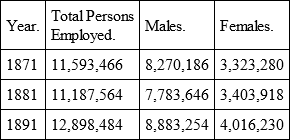
Accordingly, within twenty years, the number of males employed increased 613,068, or 7.9 per cent.; the number of females, however, by 692,950, or 20.9 per cent. It is especially to be observed in this table that, in 1881, a year of crisis, the number of males employed fell off by 486,540, and the number of females increased by 80,638. The increase of female at the cost of male persons employed is thus emphatically brought to light. But within the increasing number of female employes itself a change is going on: younger forces are displacing the older. It transpired that in England, during the years 1881-1891, female labor-power of the age 10 to 45 had increased, while that above 45 had decreased.
Industries in which female exceeded considerably the number of male labor, were mainly the following:
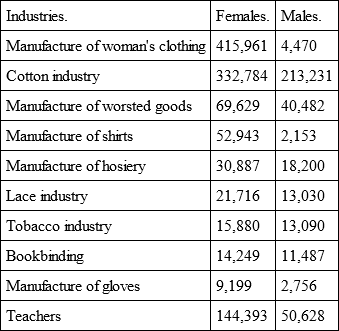
Again the wages of women are, in almost all branches, considerably lower than the wages of men for the same hours. In the year 1883, the wages in England were for men and women as follows, per week: —
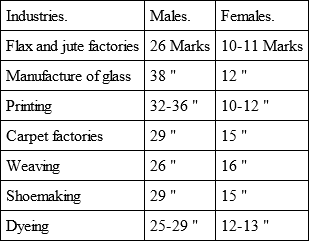
Similar differences in wages for men and women are found in the Post Office service, in school teaching, etc. Only in the cotton industry in Lancashire did both sexes earn equal wages for equal hours of work in the tending of power looms.
In the United States, according to the census of 1890, there were 2,652,157 women, of the age of ten years and over engaged in productive occupations: – 594,510 in agriculture, 631,988 in manufacture, 59,364 in trade and transportation, and 1,366,235 in personal service, of whom 938,910 were servants. Besides that, there were 46,800 female farmers and planters, 5,135 Government employes, 155,000 school teachers, 13,182 teachers of music, 2,061 artists.125 In the city of New York, 10,961 working-women participated in strikes during the year 1890, a sign that working-women in the United States, like their European fellow-female wage slaves, understand the class distinctions that exist between Capital and Labor. In what measure women are displacing the men in a number of industries in the United States also, is indicated by the following item from the "Levest. Journ." in 1893:
"One of the features of the factory towns of Maine is a class of men that may be termed 'housekeepers.' In almost every town, where much factory work is done, these men are to be found in large numbers. Whoever calls shortly before noon will find them, with aprons tied in front, washing dishes. At other hours of the day they can be seen scrubbing, making the beds, washing the children, tidying up the place, or cooking. Whether any of them attend to the sewing and mending of the family we are not quite sure. These men attend to the household for the simple reason that their wives can earn more in the factory than they, and it means a saving of money if the wife goes to work."126
The closing sentence should read: "Because the women work for wages that the men can no longer work for, and the employer therefore prefers women," – which happens in Germany also. The towns here described are the so-called "she-towns," already more fully referred to.
In France, there were, in 1893, not less than 15,958 women engaged in the railroad service (in the offices and as ticket agents); in the provincial Post Office there were 5,383 women employed; as telegraphers and telephonists, 9,805; and in the State Savings Banks 425. Altogether the number of women in France engaged in gainful occupations, inclusive of agriculture and personal service, was, in 1893, in round figures 4,415,000. Of 3,858 decisions, rendered by the trades courts of Paris, not less than 1,674 concerned women.
To what extent female labor was applied in the industries of Switzerland as early as 1886, is told by the following figures of the "Bund":

Altogether, there were then in the textile industries, 103,452 women engaged, besides 52,838 men; and the "Bund" expressly declares that there is hardly an occupation in Switzerland in which women are not found.
In Germany, according to the census of occupations of 1882, of the 7,340,789 persons engaged in gainful occupations, 1,506,743 were women; or 20.6 per cent. The proportions were, among others, these: —
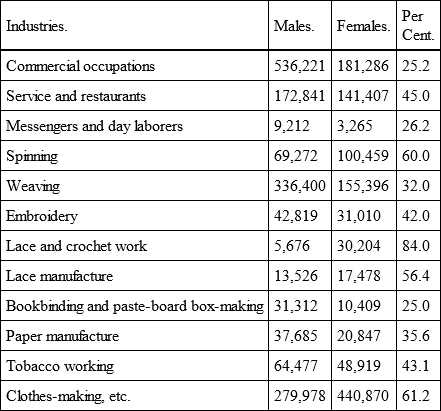
To these must be added 2,248,909 women engaged in agriculture, 1,282,400 female servants, also school teachers, artists, Government office-holders, etc.
According to the census of occupations for 1875-1882, the following was the result. There were employed in industrial occupations in the German Empire: —

According to these figures, not only did female labor increase by 35 per cent. during the period of 1875-1882, while male labor increased only by 6.4 per cent., but the great increase of female labor, especially in small industries, tells the tale that only by dint of a strong application of female labor, with its correspondingly low wages, can small production keep itself afloat, for a while.
In 1882, there were to every 1,000 persons engaged in industry 176 women; in commerce and transportation, 190; in agriculture, 312.
In 1892, the number of women, employed in the factories of Germany, were of the following ages:
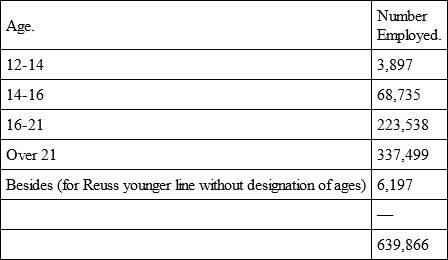
In the Kingdom of Saxony, notedly the most industrial portion of Germany, the number of working-women employed in the factories was: —
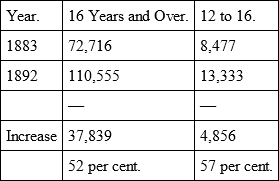
As a result of the new factory regulations, which limited the hours of female labor, between the ages of 14 to 16, to 10 a day, and wholly forbade factory work to children of school age, the number of working-women between the ages of 14 to 16 sank to 6,763, and of girls between the ages of 12 to 14, sank by 6,334. The strongest increase in the number of working-women, as far as we are informed, took place in the tobacco industry of Baden. According to the reports of the Baden Factory Inspector, Dr. Woerishoffer, the number of persons engaged in the said industry and their subdivisions by sexes; was as follows:
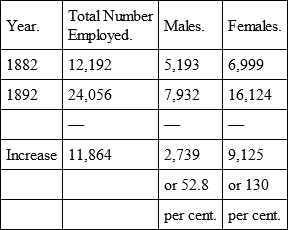
This increase in the number of female tobacco workers, denotes the sharpening competitive struggle, that has developed during the last ten years in the German tobacco as well as many other industries, and which compels the ever intenser engagement of the cheaper labor of woman.
And, as in the rest of Germany, so likewise in Baden the industrial development in general shows a larger increase of female than of male workers. Within a year, it recorded the following changes: —

Of the working-women over 16 years of age, 28.27 were married. In the large ammunition factory at Spandau, there were, in 1893, 3,000 women out of a total of 3,700 employes.
As in England, in Germany also, female labor is paid worse than male. According to the report of the Leipsic Chamber of Commerce for the year 1888, the weekly wage for equal hours were: —
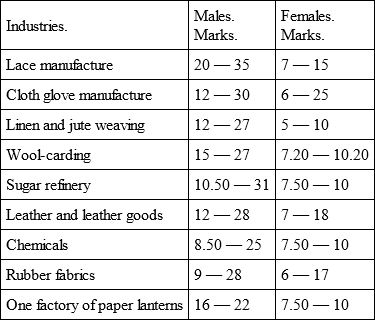
In an investigation of the wages earned by the factory hands of Mannheim in 1893, Dr. Woerishoffer divided the weekly earnings into three classes: one, the lowest, in which the wages reached 15 marks; one from 15 to 24; and the last and highest in which wages exceeded 24 marks. According to this subdivision, wages in Mannheim presented the following picture: —

The working-women earned mostly veritable starvation wages. They received per week: —
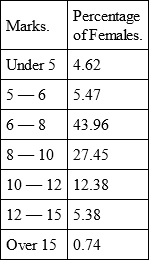
In the Thüringer Wald district, in 1891, the workingmen engaged in the slate works received 2.10 marks a day; the women 0.70. In the spinning establishments, the men received 2 marks, the women from 0.90 to 1 mark.
Worst of all are the earnings in the tenement industry, for men as well as for women, but for the women it is still more miserable than for the men. In this branch, hours of work are unlimited; when the season is on, they transcend imagination. Furthermore, it is here that the sweating system is generally in vogue, i. e., work given out by middlemen (contractors) who, in recompense for their irksome labor of superintendence, keep to themselves a large part of the wages paid by the principal. Under this system, women are also expected to submit to indignities of other nature.
How miserably female labor is paid in the tenement industries, the following figures on Berlin conditions may indicate. Men's colored shirts, paid for in 1889 with from 2 marks to 2.50, the employer got in 1893 for 1 mark 50 pfennig. A seamstress of average skill must work from early till late if she means to make from 6 to 8 of these shirts. Her earnings for the week are 4 or 5 marks. An apron-maker earns from 2 marks 50 pfennig to 5 marks a week; a necktie-maker, 5 to 6 marks; a skilled blouse-maker, 6 marks; a very skilled female operator on boys' clothing, 8 to 9 marks; an expert jacket-maker, 5 to 6 marks. A very swift seamstress on men's shirts may, in the good season, and working from 5 in the morning to 10 at night, make as much as 12 marks. Millinery workers, who can copy patterns independently, make 30 marks a month. Quick trimmers, with years of experience, earn from 50 to 60 marks a month during the season. The season usually lasts five months. An umbrella-maker, working twelve hours a day, makes 6 to 7 marks. Such starvation wages force the working-women into prostitution: even with the very plainest wants, no working-women can live in Berlin on less than 8 or 9 marks a week.
According to a statistical report on wages, ordered by the Chamber of Commerce of Reichenberg for its own district, 91 per cent. of all the working-women came under the wage category of from 2 to 5 guilders a week. Upon the enforcement in Austria of the law on sick insurance, the authorities discovered that in 116 districts (21.6 per cent. of all) the working-women earned at most 30 kreuzer a day, 90 guilders a year; and in 428 districts (78.4 per cent. of the total) from 30 to 50 kreuzer, or from 90 to 150 guilders a year. The young working-women, under 16 years of age, earned in 173 districts (30.9 per cent.) 20 kreuzer a day at the most, or at the most 60 guilders a year; and in 387 districts (69.1 per cent.) from 20 to 30 kreuzer, or from 60 to 90 guilders a year.
Similar differences between the wages of male and female labor exist in all countries on earth. According to the report on Russian industry at the Chicago Exposition in 1893, a workingman made in cotton weaving 66 marks a month, a working-woman 18; a male cotton spinner 66 marks, a female 14. In the lace industry men earned up to 130 marks, women 26; in cloth manufacture, with the power loom, a working man made 90 marks, a working-woman 26 a month.
These facts show that woman is increasingly torn from family life by modern developments. Marriage and the family, in the bourgeois sense, are undermined by this development, and dissolved. From the view point afforded by this fact also, it is an absurdity to direct women to a domestic life. That can be done only by such people, who thoughtlessly walk the path of life; who fail to see the facts that shape themselves all around, or do not wish to see them, because they have an interest in plying the trade of optimism. Facts furnish a very different picture from that presented by such gentlemen.
In a large number of industries women are employed exclusively; in a larger number they constitute the majority; and in most of the others women are more or less numerously found. Their number steadily increases, and they crowd into ever newer occupations, that they had not previously engaged in. Finally, the working-woman is not merely paid worse than the working man; where she does as much as a man, her hours are, on an average, longer.
The German factory ordinances of the year 1891 fixed a maximum of eleven hours for adult working-women. The same is, however, broken through by a mass of exceptions that the authorities are allowed to make. Nightwork also is forbidden for working-women in factories, but here also the Government can make exceptions in favor of factories where work is continuous, or for special seasons; in sugar refineries, for instance. German legislation has not yet been able to rise to the height of really effective measures for the protection of working-women; consequently, these are exploited by inhumanly long hours, and physically wrecked in the small factories, especially in the tenement house industry. Their exploitation is made all the easier to the employer through the circumstance that, until now, a small minority excepted, the women have not realized that, the same as the men, they must organize in their trades, and, there where also men are employed, they must organize jointly with them, in order to conquer for themselves better conditions of work. The ever stronger influx of women in industrial pursuits affects, however, not those occupations only that their correspondingly weaker physique especially fits them for, but it affects also all occupations in which the modern system of exploitation believes it can, with their aid, knock off larger profits. Under this latter head belong both the physically exhausting and the most disagreeable and dangerous occupations. Thus the fantastic pretence of seeing in woman only a tender, finely-strung being, such as poets and writers of fiction love to depict for the delectation of men, a being, that, if it exists at all exists only as an exception, is again reduced to its true value.
Facts are obstinate things, and it is only they that concern us. They alone preserve us from false conclusions, and sentimental twaddle. These facts teach us that to-day we find women engaged in the following occupations, among others: – in cotton, linen and woolen weaving; in cloth and flannel making; in mechanical spinning, calico printing and dyeing; in steel pen and pin making; in the preparation of sugar, chocolate and cocoa; in manufacturing paper and bronzes; in making glass and porcelain and in glass painting; in the manufacture of faience, majolica and earthen ware; in making ink and preparing paints; making twine and paper bags; in preparing hops and manure and chemical disinfectants; in spinning and weaving silk and ribbons; in making soap, candles and rubber goods; in wadding and mat making; in carpet weaving; portfolio and cardboard making; in making lace and trimmings, and embroidering; making wall-paper, shoes and leather goods; in refining oil and lard and preparing chemicals of all sorts; in making jewelry and galvanoplastic goods; in the preparation of rags and refuse and bast; in wood carving, xylography and stone coloring; in straw hat making and cleaning; in making crockery, cigars and tobacco products; in making lime and gelatine fabrics; in making shoes; in furriery; in hat making; in making toys; in the flax, shoddy and hair industries; in watchmaking and housepainting; in the making of spring beds, pencils and wafers; in making looking-glasses, matches and gunpowder preparations; in dipping phosphorus match-sticks and preparing arsenic; in the tinning of iron; in the delicacy trade; in book printing and composition; in the preparation of precious stones; in lithography, photography, chromo-lithography and metachromotype, and also in the founding of types; in tile making, iron founding and in the preparation of metals generally; in the construction of houses and railroads; in electrical works; in book-binding, wood-carving and joining; in the making of footwear and clothing; file making; the making of knives and brass goods; in manufacturing combs, buttons, gold thread and gas implements; in the making of tanned goods and trunks; in making starch and chicory preparations; in metallurgy, wood-planing, umbrella making and fish manufacturing; the preservation of fruit, vegetables and meat; in the making of china buttons and fur goods; in mining above ground – in Belgium also underground after the women are 21 years old; in the natural oil and wax production; in slate making and stone breaking; in marble and granite polishing; in making cement; the transportation of barges and canal boats. Also in the wide field of horticulture, agriculture and cattle-breeding, and all that is therewith connected. Lastly, in the various industries in which they have long been considered to have the right of way: in the making of linen and woman's clothing, in the several branches of fashion, also as saleswomen, and more recently as clerks, teachers, kindergarten trainers, writers, artists of all sorts. Thousands upon thousands of women of the middle class are being utilized as slaves in the shops and in the markets, and are thereby withdrawn from all domestic functions, the training of children in particular. Finally, there is one occupation to be mentioned, in which young, especially pretty, girls are ever more in demand, to the great injury of their physical and moral development: it is the occupation in public resorts of all sorts as bar-maids, singers, dancers, etc., to attract men in quest of pleasure. This is a field in which impropriety runs riot, and the holders of white slaves lead the wildest orgies.





